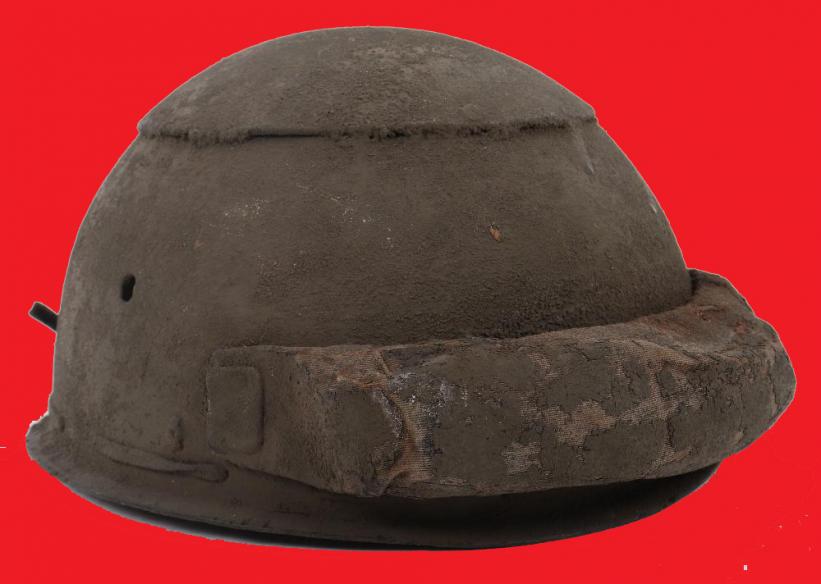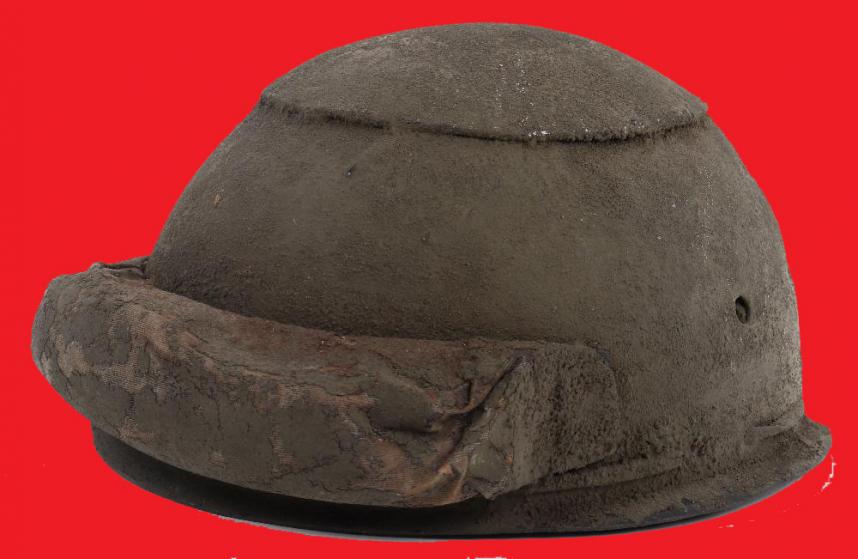A Most Rare Original WW2 British Early War Issue Pattern Tank Crew Helmet,
A fabulous early WW2 British tanker's helmet of fibre body shell with enforced plate to the top and padded front section. Exterior of the helmet is finished in a rough textured paint finish. Original liner with leather sweatband having broad arrow stamp underneath. Shows some wear with some of the exterior paint flaking and the padded front section is slightly crushed. The RAC was created on 4 April 1939, just before World War II started, by combining regiments from the cavalry of the line which had mechanised with the Royal Tank Corps (renamed Royal Tank Regiment). As the war went on and other regular cavalry and Territorial Army Yeomanry units became mechanised, the corps was enlarged. A significant number of infantry battalions also converted to the armoured role as RAC regiments. In addition, the RAC created its own training and support regiments. Finally, in 1944, the RAC absorbed the regiments of the Reconnaissance Corps. The 7th Armoured Division was an armoured division of the British Army that saw distinguished active service during World War II, where its exploits in the Western Desert Campaign gained it the Desert Rats nickname.
After the Munich Agreement, the division was formed in Egypt during 1938 as the Mobile Division (Egypt) and its first divisional commander was the tank theorist Major-General Sir Percy Hobart. In February 1940, the name of the unit was changed to the 7th Armoured Division.
The division fought in most major battles during the North African Campaign; On 7 June, the division was again prepared for battle as part of Operation Battleaxe, having received new tanks and additional personnel. In the attack plan for Operation Battleaxe, the 7th force was divided between the Coast Force and Escarpment Force. However, this Allied push failed, and the 7th Armoured Division was forced to withdraw on the third day of fighting. On 18 November, as part of Operation Crusader the whole of the 7th Armoured Division was concentrated on breaking through. They faced only the weakened 21st Panzer Division. However, the XXX Corps commander, Lieutenant-General Willoughby Norrie, aware that the 7th Armoured Division was down to 200 tanks, decided on caution. During the wait, in the early afternoon of 22 November, Rommel attacked Sidi Rezegh with the 21st Panzer and captured the airfield. Fighting was desperate and gallant: for his actions during these two days of fighting, Brigadier Jock Campbell, commanding the 7th Support Group, was awarded the Victoria Cross. However, the 21st Panzer, despite being considerably weaker in armour, proved superior in its combined arms tactics, pushing the 7th Armoured back with a further 50 tanks lost (mainly from the 22nd Armoured Brigade).
On 27 June 1942, elements of the 7th Armoured Division, along with units of the 3rd The King's Own Hussars, suffered one of the worst friendly fire incidents when they were attacked by a group of Royal Air Force (RAF) Vickers Wellington bombers during a two-hour raid near Mersa Matruh, Egypt. Over 359 troops were killed and 560 others were wounded.
The Western Desert Force later became HQ XIII Corps, one of the major parts of the British Eighth Army which, from August 1942 was commanded by Lieutenant-General Sir Bernard Montgomery. The 7th Armoured Division took part in most of the major battles of the North African Campaign, including both battles of El Alamein (the First Battle of El Alamein in July 1942, which stopped the Axis advance, and the Second Battle of El Alamein in October/November 1942, which turned the tide of the war in North Africa).
Infantrymen of the 1/6th Battalion, Queen's Royal Regiment (West Surrey) marching into Tobruk, Libya, 18 November 1942.
The 7th Armoured Division, now consisting of the 22nd Armoured and 131st Infantry Brigades and commanded by Major General John Harding, fought in many major battles of the Tunisian Campaign, taking part in the Battle of El Agheila in December. By January 1943 the Eighth Army had reached Tripoli where a victory parade was held, with the 7th Armoured Division taking part. Among the witnesses was Winston Churchill, the British Prime Minister, and General Sir Alan Brooke, the Chief of the Imperial General Staff (CIGS).
The division, now commanded by Major General George Erskine after Harding was severely injured in January, next took part in the Battle of Medenine, followed by the Battle of the Mareth Line in March. In late April, towards the end of the campaign, the 7th Armoured Division was transferred to IX Corps of the British First Army for the assault on Medjez El Bab. The attack was successful, with the 7th Armoured Division competing with the 6th Armoured Division of the First Army in a race to the city of Tunis, with 'B' Squadron of the 11th Hussars being first into the city on the afternoon of 7 May, followed closely by the 22nd Armoured Brigade and the 131st Brigade. The fighting in North Africa came to an end just days later, with almost 250,000 Axis soldiers surrendering to the Allies and becoming POWs
Code: 23340
695.00 GBP







